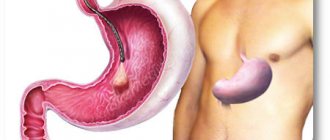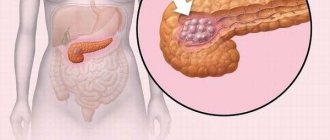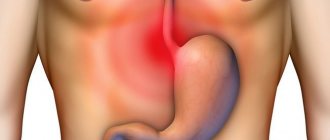Sometimes, as a result of the action of unfavorable factors, pathogenic growths, which are commonly called polyps, form in the main organ of the digestive system (in the antrum). Outgrowths can be single or multiple. In the cavity of the internal organ, focal forms of the disease are more common, accompanied by the formation of a large number of tumors.
The risk group for the disease consists of men aged 40-50 years. In women, the pathology is less common. However, this does not mean that the problem cannot arise in young adults or in children.
Polyps in the stomach are a benign pathology of the internal walls of the organ, in which growths form from glandular epithelial cells. Their base is a thin stalk (lancet polyps) or an expanded platform (sessile polyps). The shape of the growths resembles mushrooms, balls, papillae, ovals. The degree of their softness depends on the number of glandular cells in the structure of the growth: if there are many of them, it is soft. The disease has ICD-10 code D13.1.
The color of polypous growths can be gray, pink, flesh-colored, or red. The size of the neoplasms is 5-60 mm. Polyps with a diameter of 15 mm are more common. The size of the growth is directly related to its ability to degenerate into cancer. Malignization of large growths into cancer is common.
Types of gastric polyps
They are most often localized in the area of the pylorus of the stomach (70% of all polyps of the digestive organ) or near the cardiac region (30% of polyps). Gastric polypous formations can be classified into types according to different principles. From the point of view of morphological structure there are:
Polyp in the stomach
- Diffuse polyposis is a rare pathology.
- Adenomatous polyposis is a form of the disease that in 20% degenerates into oncology. They need to be removed, such polyps grow quickly. This type of polyp is divided into tubular forms, papillotubular and papillary.
- Tubular polyp - outgrowths containing fundic glands, limited around the perimeter by connective tissue. Such polyps more often than others develop into cancer.
- Papillary polyps are villous growths formed by cells of the mucous layer. A characteristic feature of these polyps is the presence of finger-like formations on their body.
- Papillary-tubular polyps are growths in the structure of which glandular cells and cells of the mucous layer are found.
- Hyperplastic polyp - with this type of pathology, the outgrowths have a normal morphological structure, but a glandular component is found in their structure. The pathology occurs as a result of epithelial hyperplasia and is not associated with cellular mutations. They appear due to the inflammatory process, gastroinfection. These polyps are considered common and account for 70% of all types of gastric outgrowths. These growths rarely turn into cancerous forms of pathology. However, this does not make them any less dangerous: the formations cause stagnation of food and bleeding.
- Xanthoma is a benign growth on the wall of the gastric organ, which was formed as a result of excess lipid deposition.
- A miliary polyp is a millet-like form of neoplasm, the cause of which may be tuberculosis.
Based on the number of outgrowths, the classification distinguishes between single and multiple formations. Multiple forms of polyposis are inherited from parents to children. They are located on a wide base. Multiple growths cover the entire inner layer. The pathology is classified as multiple if a person has more than 3 growths. They are divided into:
Gastric polyp removal
- Peutz-Jeghers polyp - this neoplasm combines growths in the gastrointestinal tract, a change in the color of the skin, and the structure of the mucous layer becomes deformed.
- Gardner's polyp is a pathology that combines growths on the walls of the stomach and damage to the colon and rectum by growths. This type of multiple polyposis gives rise to concomitant diagnoses: fibroma, osteoma, lipoma.
- Juvenile polyposis is an autosomal dominant form of the disease with hamartomatous growths affecting the antrum, large and small intestine. The structural feature of this type of outgrowth is elongated branched cysts. An inflamed swelling appears on the mucous membrane around the site of their formation. Inside these outgrowths are filled with mucus. Pathology is rare. The risk group for this type of polyposis is children under 10 years of age. With a small area of damage, juvenile polyposis can resolve on its own. If the disease progresses, the outgrowths acquire an oncological structure.
Determining the type of growth is considered the first step in diagnosis, since different types of polyps need to be treated in different ways.
General information about pathology
These neoplasms are the leading precancerous conditions in the stomach. Among all tumors that form in the gastrointestinal tract, polyps make up about 10%. Their formation is typical in patients over 50 years of age. At the same time, women are affected by the disease much less often than men.
The insidiousness of the pathology lies in the asymptomatic clinical course in the early stages. A tumor of this type is often discovered accidentally during an examination for other gastrointestinal diseases.
The benign nature of neoplasms is not a reason to ignore the treatment of gastric polyps if they are accidentally discovered, even if there is a complete absence of discomfort and symptoms. In an advanced state, polyposis poses a serious threat to the patient’s life due to the increasing risk of degeneration into oncology. Therefore, treatment should begin immediately after identifying epithelial formations on the walls of the stomach.
Dangers of gastric polyposis
Gastric polyposis is considered a dangerous disease, as it is associated with negative manifestations:
- Indigestion. Due to the enlarged tumor, it is difficult for food to enter the intestines. A person suffers from constant bouts of vomiting, which can lead to an aversion to food. He is rapidly losing weight.
- If there is a polyp in the digestive organ, there is a risk of pinching its legs. The situation is accompanied by acute pain and threatens internal bleeding. When a polyp is localized near the gastric outlet, it can interfere with the movement of food into the duodenum - the process of its rotting and putrefactive vomiting begins. This complication requires emergency hospitalization of the patient. But the situation is complicated by the fact that a person does not immediately find out about the bleeding of the polyp. Late seeking of medical help means that doctors may not have time to save the person.
- Bleeding polyps. A stomach polyp may bleed intensely or unnoticed. Both bleedings are equally dangerous. Hidden bleeding leads to anemia and hypoxia of body tissues, and excessive bleeding poses a threat to the patient’s life.
Adenomatous polyp
- If the polyp is adenomatous, there is a risk that the disease will become malignant. If this happens, not only the gaster, but also other organs and systems will be involved in the pathological process: oncology can metastasize through the blood and lymph. With such a clinical picture, doctors do not guarantee a favorable outcome. Oncology often relapses even after surgical removal of the tumor, and it is also not possible to eliminate metastases with medication. Therefore, the patient is prescribed powerful opiates that suppress pain, but do not eliminate the cause of its occurrence.
Symptoms of pathology
Often this is not an independent pathology, but a complication of a disease of the digestive organ, so the signs of polyposis overlap with other disorders of the gastrointestinal tract.
The severity of the symptoms of the disease is determined by the size of the outgrowths: the larger they are, the more acute the signs of the pathological process. The presence of symptoms is also influenced by the histological nature of the growth. Symptoms of gastric polyposis include:
- flatulence;
- heartburn;
- nausea and vomiting (vomit may contain blood, rotten food debris with an unpleasant odor);
- alternating diarrhea and constipation;
- epigastric epigastric pain associated with eating (if the polyp is located in the upper part of the stomach, then pain appears immediately after eating; pathology of the middle and lower parts of the organ is characterized by the appearance of pain 1-1.5 hours after eating);
- a feeling of distension of the prepyloric section in the stomach;
- feeling of fullness in the stomach;
- bad breath;
- stomach bleeding;
- dark color of stool;
- decreased blood pressure against the background of an accelerated pulse;
- low heart rate;
- pale skin;
- the appearance of perspiration;
- complicated evacuation of food from the stomach (when polyps are localized in the pyloric part of the organ);
- signs of rotting food that has stagnated in the stomach;
- reduced hemoglobin as a result of prolonged internal latent bleeding;
- anemia;
- pain similar to contractions;
- hemorrhagic shock.
Diagnostics
A gastroenterologist knows what a polyp in the stomach is, and it is this specialist who should seek qualified help if one or more of the above symptoms occur.
First of all, the specialist needs to:
- get acquainted with the medical history and life history of the patient - to determine the most likely predisposing factor;
- conduct a thorough physical examination, which is based on palpation of the anterior wall of the abdominal cavity - while the doctor monitors the person’s reaction;
- interview the patient in detail regarding the first time of onset and severity of symptoms.
The second step of diagnosis is laboratory tests, including:
- general clinical blood test - to detect signs of anemia;
- blood biochemistry - will indicate the occurrence of a pathological process in the body;
- microscopic examination of stool - to determine the presence of occult blood;
- serological tests - to search for antibodies to Helicobacter pylori.
The most informative diagnostic tests are instrumental examinations. Such diagnostics involve performing:
- radiography of the stomach;
- gastroscopy;
- ultrasonography;
- FGDS;
- biopsy – for subsequent histological examination of the biopsy;
- endoscopic procedures.
Causes of gastric polyposis
Causes of growths in the gastric mucosa:
Helicobacter pillory
- The presence of the bacterium Helicobacter pillory in the stomach, the activity of which causes erosion and the formation of ulcers on the walls of the organ. The prolonged presence of bacteria in the body increases the likelihood of developing cancer.
- Genetic predisposition (determined by the presence in the patient’s immediate family history of adenomatous polyps of the stomach or gastrointestinal oncology).
- Human transfer of ionizing radiation exposure. The inner lining of the stomach is one of the first to react to radiation flows. Radiation exposure causes multiple polyposis and is accompanied by large areas of damage in the stomach.
- Poor nutrition. Tendency to consume smoked meats, marinades, and canned food. High levels of nitrates and nitrites in human foods also have a negative impact on health. Alcoholic drinks have a destructive effect on the gastric mucosa.
- Tobacco smoking. Doctors have proven that nicotine destroys gastric epithelial cells. In turn, the destructive process leads to oncology.
- Long-term use of non-steroidal anti-inflammatory drugs The components that make up these medications have a strong effect on the mucous layer - it becomes overly sensitive and vulnerable.
- A course of antibiotics and neglect after it of drugs such as Bifidumbacterin. After antibiotics, it is necessary to take special medications that help restore the gastric microflora and prevent the development of dysbiosis.
- The patient’s tendency to self-medicate and use unconventional methods of treating certain diseases, and to neglect medications. Uncontrolled use of medications and self-prescription of medications lead to the fact that a person may develop symptoms of persistent disorders of the digestive system.
- Chronic inflammatory process in the stomach. Infection of the gastric epithelium leads to the formation of fibrous compactions in it, which threaten the opening of bleeding.
- Various forms of antrum or a history of gastric ulcer. Particularly often, the cause of the development of polyposis in the stomach is chronic polyadenomatous gastritis.
- The presence of human papillomavirus in active form.
- Impact of chemicals on the body. This happens when you eat foods high in nitrates or work in industries that involve heavy metals.
- Digestive system disorders (stomach ulcer, all types of gastritis). Violation of the cardia rosette.
- Unfavorable environmental conditions in the area where a person lives.
- Decreased immunity.
Causes of stomach polyps
The causes of stomach polyps vary depending on the type. For example, the cause of the appearance of sporadic glandular polyps has not yet been reliably established. According to some reports, the reason for their growth may be the regular use of proton pump inhibitors - drugs that are prescribed for ulcers, GERD and other acid-related diseases. In this case, the polyps disappear spontaneously within about three months after the end of therapy.
In familial adenomatous polyposis, the cause of the disease is heredity. The disease is passed on from generation to generation; polyps affect not only the gastric mucosa, but also the intestines, which greatly increases the likelihood of developing colorectal cancer.
Hyperplastic polyps are directly related to Helicobacter pylori infection and can be considered a sign of disruption of normal mucosal regeneration. The reason for the appearance of sporadic adenomatous polyps is also similar: as a rule, they develop against the background of atrophic gastritis and intestinal metaplasia (changes in the structure of cells of the mucous membrane).
Diagnosis of the disease
The disease is diagnosed endoscopically or through X-ray diagnostics. Laboratory tests are used as additional diagnostic measures.
Endoscopy
Endoscopy involves inserting a flexible tube into the stomach cavity with an eyepiece at the end that transmits an image to a monitor. The method allows you to see in detail the surface of the gastric walls and assess the extent of their damage by polyposis.
A variant of endoscopy is gastroscopy (FGDS). This technology can be both diagnostic and serve the purpose of removing the growth. For stomach polyps, this is the optimal diagnosis.
The endoscopy technique involves:
- Treating the patient's oropharynx with an anesthetic.
- Installation of a mouthpiece into the oral cavity, through which an endoscope is inserted into the esophagus. To prevent the gag reflex, a person needs to breathe deeply.
- Air supply through the endoscope to straighten the folds of the stomach.
- Carrying out a biopsy if a polypous formation is detected. A tissue fragment of the growth is sent for diagnostics to determine the nature of the growth.
- Removing the endoscope from the stomach.
X-ray examination
An X-ray machine and contrast agent are used as a diagnostic tool for gastric polyps when ecdoscopy is not possible. Before starting the study, the patient needs to drink a barium suspension, which acts as a contrast agent. Then the doctor takes a series of photographs of the stomach in different projections.
Remember, this method of instrumental diagnosis cannot be performed on pregnant women and patients with gastric bleeding. This type of diagnosis is difficult if the patient is in a serious condition and if the patient has problems with swallowing.
Laboratory diagnostics
The results of instrumental diagnostics must be confirmed by laboratory tests. A person must submit:
- Complete blood count to confirm or rule out occult bleeding (stomach bleeding would be indicated by a low hemoglobin level and low red blood cell count in the blood sample).
- Examination of stool for the presence of foreign impurities.
- PCR analysis. This laboratory diagnostic technique involves conducting a breath test and additional examination of the composition of the patient’s saliva.
- Fibrogastroscopy.
- Biopsy.
- Cytology.
- Histology.
Treatment of pathology
Modern medicine offers various ways to treat tumors in the stomach. This includes surgical intervention, drug therapy, and hospital monitoring. The pathology can be cured without surgery. In some cases, the polyp may resolve on its own if the patient normalizes nutrition and follows clinical recommendations.
Conservative therapy
If, based on the results of instrumental and laboratory diagnostics, the doctor does not see a significant threat to the patient’s life, he decides on drug treatment of the polyp. This treatment technology is optimal for a single growth, when it is necessary to observe how the neoplasm behaves and whether it will increase in size. This approach to treatment involves not only taking medication, but also following a strict diet and special diet.
Conservative therapy is based on the patient taking medications such as:
- "Almagel" is a modern drug that has an enveloping effect. This remedy protects the walls of the stomach from the harmful effects of hydrochloric acid. The product has proven itself in the treatment of bleeding polyps. The amount of a single dose of the drug is determined by the doctor
- “Almagel A” is a product that has similar properties and effects as “Almagel”, but additionally the drug contains an anesthesin that relieves pain. The dosage of the drug is determined by the doctor.
- Omeprazole is a drug that suppresses the production of hydrochloric acid in the stomach. It destroys parietal cells. Such drugs promote the regeneration of the mucous layer. The treatment regimen using this remedy is prescribed by the doctor, taking into account the individual characteristics of the clinical case.
- “De-nol” is a product that acts as a chemical barrier between the walls of the stomach and hydrochloric acid. A course of taking De-nol prevents the formation of glandular polyps. In addition, this drug destroys the stomach bacterium Helicobacter pillory. The dosage and duration of taking the drug is determined by the doctor.
- "Gastal" is a medicine that reduces the production of gastric juice. The medicine affects the epithelium of the stomach, increasing its protective properties. The drug can be recommended for a short course or once.
- "Rennie" - normalizes the process of hydrochloric acid production, relieves severe pain, and successfully fights acidic heartburn. The doctor will suggest the optimal treatment regimen using this medication.
- Clarithromycin is a drug that destroys the bacterium Helicobacter pillory in the stomach. To achieve a lasting positive effect in treatment, it is necessary to take the drug for at least 7 days.
- "Klacid" is a drug that successfully destroys bacteria that cause gastritis. In addition, the product successfully fights infections in the stomach and reduces the acidity of gastric juice.
Drug treatment of polyps involves registering the patient with a dispensary. If conservative treatment does not allow recovery, the tumor must be removed.
Even after a favorable outcome of the disease, a person needs to regularly visit a doctor and get tested. Monitoring the condition of the stomach using gastroscopy is mandatory. It will also be useful to take vitamin and mineral complexes, agreed upon with your doctor. This will increase the overall immunity of a person.
Surgery as a way to combat gastric polyposis
Polyps in the stomach do not always require removal through surgery. Surgery is resorted to when drug therapy for tumors does not produce a positive result.
Indications for the operation are:
- the size of the outgrowths is more than 15 mm;
- the patient feels the presence of a foreign body in the stomach;
- there are pronounced symptoms that threaten the patient’s life;
- Based on the diagnostic results, it was established that the tumor-like growth is of an oncological nature.
The operation to remove growths can be performed by different means. The choice of one or another surgical technology remains with the doctor and is based on the severity of symptoms, the size of the tumors, and the age of the patient. Modern methods of surgical intervention are:
- Endoscopic polypectomy (endoscopy) is an operation using an endoscope. The necessary instruments are inserted into the stomach cavity through the lumen of the esophagus, with the help of which the pathogenic formation is cut off or destroyed. This type of operation is divided into 3 types:
- Mechanical endoscopic polypectomy is an operation in which the tumor is cut off using a metal loop and removed from the stomach through an endoscope. The danger of the method is the high risk of developing gastric bleeding.
- Electroexcision - polypectomy, is used to rid a person of growths with a diameter of up to 30 mm. The procedure consists of eliminating the tumor using an electrical loop. This is a technique that allows you to get rid of single and multiple growths in the stomach. The likelihood of bleeding in this case is minimal.
- Electrocoagulation is a method of removing polyps by exposing them to high-frequency current. The principle of operation of this technique is based on applying biopsy forceps to the polyp, through which it is heated. As a result of heating, the structural elements of the outgrowth are destroyed.
Removal of a polyp
3 months after endoscopic removal of polyps, a person must undergo gastroscopy to assess the condition of the stomach walls and identify relapse of pathology in the early stages. If residual growths are detected, electrocoagulation is performed. After this, for 2 months the person must take maintenance therapy medications recommended by the doctor and follow a diet.
- Open surgery is a method of surgically removing polyps in the stomach using a scalpel. The wall of the stomach is cut with a medical instrument, then the body of the polyp is excised. This type of surgery is used to remove large polyps that tend to grow together. This technology also successfully copes with the removal of growths that do not have a stem.
The operation is performed under general anesthesia. The doctor gradually cuts the tissue, penetrating the main organ of the digestive system. The neoplasm is removed from the wall along with the adjacent mucous layer. After the polyp is removed, the edges of the cut tissues are sutured.
Open surgery is rarely used; the technology often entails undesirable consequences. There is a high probability of infection of the patient's tissues. After this medical procedure, pneumonia, intestinal obstruction, and thrombosis often develop. Possible disturbances in the functioning of the cardiovascular system.
The removed growth is sent for histological examination.
- Resection is a type of radical surgery associated with global tissue trauma. Along with the growth, part of the digestive system organ is also removed. Many complications arise after surgery. A person has a rapid heartbeat, it is impossible to even out the heart rhythm, he experiences weakness and constant vomiting. A serious complication is the appearance of dumping syndrome in the patient. The danger of resection of polyps is due to the fact that after removal of the tumor, oncology of the remaining stomach tissue often develops.
This type of surgical removal of growths is used only in extreme cases. Indications for this medical procedure are:
- huge size of growths;
- the tendency of polyps to coalesce and form large affected areas;
- reappearance of the disease;
- there is pinching of a polyp on a thick stalk or tissue necrosis;
- the polyp causes intestinal obstruction;
- high probability of the growth becoming a cancerous tumor of the cardioesophageal junction;
- a malignant component was found in the structure of the neoplasm.
- New growths are also removed with a laser.
Regardless of the chosen surgical technology, the operation is performed under general anesthesia.
It should be remembered that surgery to remove pathogenic growths in the stomach is contraindicated for patients with pacemakers and people suffering from hemophilia. Surgery is not recommended if the patient is in serious condition.
Removing polyps surgically does not guarantee that a person will never encounter the problem again. This type of therapy is associated with the risk of perforation of the gastric walls.
Possibilities of traditional medicine in the treatment of gastric tumors
It is recommended to discuss the use of a specific traditional medicine recipe with your doctor. For stomach polyps, the following herbal remedies are effective:
- Oat infusion. This plant is used to cleanse the digestive tract. It helps eliminate toxins and waste. The advantage of the product is the absence of side effects. To prepare the infusion, take 2 tablespoons of oats and add 2 liters of water. Heat the mixture and cook for 30 minutes. The resulting broth is poured into a glass jar, closed with a lid and put in a dark place for 2 days. After this, add 50 g of honey to the infusion and heat the mixture over low heat. Drink half a glass of infusion half an hour before meals 3 times a day.
- Infusion of walnut partitions. To prepare a healing infusion, take partitions from the shells of 20 nuts, place them in a glass jar and fill them with water. After this, the jar is closed and placed in a dark place for 7 days. The mixture needs to be shaken periodically. Drink the resulting infusion on an empty stomach, 2 tablespoons.
- Sea buckthorn oil and juice. The juice is squeezed from the stems of sea buckthorn. The stems are dried and crushed. The resulting powder is poured with sunflower oil. The oil mixture must be infused for 30-60 days. Take 1 teaspoon 3 times a day before meals.
Features of human nutrition after removal of a polyp in the stomach
The final stage of treatment is the patient's compliance with special nutritional rules. The diet after treatment of pathology is aimed at restoring the mucous layer of the stomach and normalizing the functioning of the organ.
Dietary nutrition lasts from 2 weeks to 6 months. Thus, with endoscopic removal of a polyp, tissue restoration occurs quickly, so there is no need for a long-term dietary regimen.
On the first day after surgery, the patient should not eat. From day 2 you can start eating small portions. First, the patient is given pureed dishes, giving preference to liquid porridges and soups. A person will have to give up for some time those foods that can cause mechanical damage to the walls of the digestive tract and have a negative chemical effect on the digestive organ. Avoiding hot food will help avoid burns to the weakened epithelium.
The diet after surgery is based on foods such as:
- porridges that are cooked a little longer than necessary;
- biscuits and crackers;
- soups with secondary broth;
- chicken;
- lean fish;
- non-acidic fruits;
- fresh vegetables;
- pasta;
- drinking yoghurt;
- herbal tea;
- low-calorie fermented milk products.
In the postoperative period, the patient must avoid foods such as:
- semolina;
- coffee;
- strong tea;
- baking and bakery products;
- marinades and canned food;
- everything is fat;
- sauces and spices;
- peas;
- cabbage;
- radish;
- radish;
- figs;
- plums;
- grape;
- fried eggs;
- margarine;
- fatty fermented milk products.
If a person grossly violates the doctor’s dietary recommendations, an erosive symptom will appear.
Prevention of gastric polyposis
Like any other disease, gastric polyposis is easier to prevent than to treat. The main prevention is for a person to systematically undergo periodic medical examinations in order to promptly notice the emerging growth. In addition, following recommendations for organizing a healthy lifestyle prevents the development of polyps:
- The drinking regime should be observed. Not counting soups, drinks and juices, a person should drink 2-2.5 liters of clean boiled water per day. It is useful to start the day by drinking a glass of plain water. Nutritionists also recommend drinking a glass of water before each meal, and not drinking immediately after eating.
- Stick to a balanced diet.
- You need to adjust your diet.
- Do not eat food that is too hot or too cold.
- Give preference to steamed dishes.
- Replace tea and coffee with herbal drinks.
- A sedentary lifestyle and smoking should be abandoned forever. Remember, walking in the fresh air improves your well-being and strengthens your immune system. It is worth walking 3-5 km a day.
- If a person is diagnosed with a polyp in the stomach during a medical examination, he will have to undergo a comprehensive examination and treatment.
- If alarming symptoms are detected, a person should immediately contact a therapist or gastroenterologist. Decoding it will allow you to understand what to do next.
Prevention
As recommendations for prevention, experts advise:
- lead a healthy lifestyle;
- no smoking;
- do not abuse alcoholic beverages;
- refuse self-medication;
- Healthy food;
- move more;
- promptly contact specialists if alarming symptoms appear.
No special preventive measures are provided. They simply don't exist. Following your doctor's recommendations and paying close attention to your health will help prevent the likelihood of serious complications.











